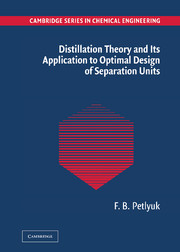Book contents
- Frontmatter
- Contents
- Preface
- Acknowledgements
- Nomenclature
- 1 Phase Equilibrium and Its Geometric Presentation
- 2 Basic Concepts of Distillation
- 3 Trajectories of Distillation in Infinite Columns Under Infinite Reflux
- 4 Trajectories of Thermodynamically Reversible Distillation
- 5 Distillation Trajectories and Conditions of Mixture Separability in Simple Infinite Columns at Finite Reflux
- 6 Distillation Trajectories in Infinite Complex Columns and Complexes
- 7 Trajectories of the Finite Columns and Their Design Calculation
- 8 Synthesis of Separation Flowsheets
- Short Glossary
- Index
- References
5 - Distillation Trajectories and Conditions of Mixture Separability in Simple Infinite Columns at Finite Reflux
Published online by Cambridge University Press: 08 August 2009
- Frontmatter
- Contents
- Preface
- Acknowledgements
- Nomenclature
- 1 Phase Equilibrium and Its Geometric Presentation
- 2 Basic Concepts of Distillation
- 3 Trajectories of Distillation in Infinite Columns Under Infinite Reflux
- 4 Trajectories of Thermodynamically Reversible Distillation
- 5 Distillation Trajectories and Conditions of Mixture Separability in Simple Infinite Columns at Finite Reflux
- 6 Distillation Trajectories in Infinite Complex Columns and Complexes
- 7 Trajectories of the Finite Columns and Their Design Calculation
- 8 Synthesis of Separation Flowsheets
- Short Glossary
- Index
- References
Summary
Introduction
This chapter is the central one of the book; all previous chapters being introductory ones to it, and all posterior chapters arising from this one. Distillation process in infinite column at finite reflux is the most similar to the real process in finite columns. The difference in results of finite and infinite column distillation can be made as small as one wants by increasing the number of plates. Therefore, the main practical questions of distillation unit creation are those of separation flowsheet synthesis and of optimal design parameters determination (i.e., the questions of conceptual design) that can be solved only on the basis of theory of distillation in infinite columns at finite reflux.
The significance of such theory and, in particular, the significance of development of minimum reflux number calculation methods has been clear for numerous investigators all over the world since the beginning of distillation science development. A great number of publications have been devoted to these questions. However, the general distillation theory at finite reflux was created only lately on the basis of unification of several important ideas and theories of geometric nature. One can refer to the latter the idea of examination of distillation trajectory bundles at finite reflux for fixed product composition, the conception of sharp separation of multicomponent mixtures, the theory of location of reversible distillation trajectories in the concentration simplex, the theory of trajectory tear-off from the boundary elements of concentration simplex at finite reflux, and the theory of section trajectories joining.
- Type
- Chapter
- Information
- Publisher: Cambridge University PressPrint publication year: 2004



